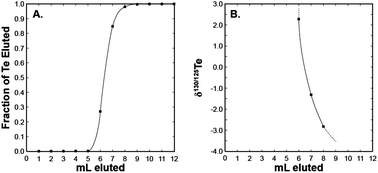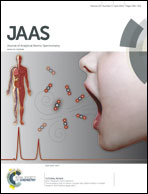Methods for the determination of stable Te isotopes of minerals in the system Au–Ag–Te by MC-ICP-MS
Abstract
The measurement of stable isotopes in ore- and ore-related minerals can provide insight into the geochemistry and formation of metal-bearing ore systems. Currently, there are few high-precision studies of the natural variability of stable tellurium isotopes, most of which are focused on meteorites and sulfides and are related to cosmogenesis; there are no modern studies on the variability of tellurium isotopes within native tellurium and tellurides from ore-forming systems. Tellurium is an element of interest due to its common association with gold in geologic systems, as well as its rarity in the Earth's crust and increasing industrial demand for applications such as photovoltaics. This study presents a method by which tellurium can be sampled from Au–Ag tellurides and native tellurium, isolated by ion exchange chromatography, and analyzed for isotopic composition by multi collector-inductively coupled plasma-mass spectrometry (MC-ICP-MS). Using a micromill, a sufficient mass of telluride or native Te sample can be extracted from coexisting ore and gangue minerals from ∼100 μm wide by ∼50 μm deep drilled holes. Acid digestion of micromilled samples and subsequent ion exchange chromatography isolated Te from matrix metals. The chromatography procedure has Te yields of 96% and produces no net fractionation of Te isotopes. MC-ICP-MS analyses were performed using two techniques, both of which employed the doping of samples using Cd to correct for instrumental mass bias. The first method was the introduction of 100 ppb Te-bearing solutions (with 100 ppb Cd) using a desolvating nebulizer (Aridus II). The second method involved solution nebulization of 2 ppm solutions of Te (with 1 ppm Cd) into the plasma of the MC-ICP-MS. Although the wet and dry methods produce statistically identical delta values, precision is increased using the wet method. The average uncertainty (two standard deviations of the mean) using the Aridus II is ±0.20‰ for 130/125Te (dry method), whereas that for the wet method is ±0.08‰. Repeated analyses of the Te standard over a period of ∼15 months by solution nebulization yielded an external precision of ±0.10‰ for 130/125Te. Natural, hypogene tellurides (calaverite, hessite, krennerite, and sylvanite) and native tellurium samples (n = 32) have a range of 1.64‰ in the isotope composition 130/125Te, demonstrating resolvable, disparate isotope ratios between samples from different areas and between samples from the same locality (e.g., Cripple Creek, Colorado). Fractionation of Te isotopes was caused by mass-dependent geological processes.


 Please wait while we load your content...
Please wait while we load your content...